Far East Coast, China
On October 1, 1998, I found myself flying over the Himalayan range and the famous peak K2, over the Gobi desert, and into Beijing, China. My family often takes advantage of the opportunity afforded by having relatives and friends in far-flung places and this year, we decided to visit my father's brother's wife's sister's husband who was stationed in Beijing with his family. We arrived bleary-eyed and exhausted after the long flight, but the thrill of being in a new country soon woke us up.
Because it was a national holiday, the anniversary of the formation of the People's Republic  of China, we planned to go to Tiananmen Square where all the festivities were going to occur over the long weekend. However, since traffic was hellish with throngs of cars, busses, bicycles, and people standing still on the road-turned-parking-lot, we decided to forgo that
of China, we planned to go to Tiananmen Square where all the festivities were going to occur over the long weekend. However, since traffic was hellish with throngs of cars, busses, bicycles, and people standing still on the road-turned-parking-lot, we decided to forgo that
evening’s entertainment and instead found a little out of the way barbecue restaurant for our first meal in China.
We passed on the barbecued scorpion and stuck with the chicken and beef. We found the food quite tasty and unburdened by the heavy sauces found in the American versions of

Chinese food. After a filling meal, we returned to our host’s house which was located in an artery of this city’s heart – close to the city center, but a bit away from the populace as it was the area set apart for many foreigners residing in Beijing.
My eyes were dazzled by all the neon lights and advertisements glowing, blinking, and shining along the street below. If you have seen the movie “Blade Runner” then you'd have a good idea of what the scene looked like. Sliding the heavy drapes together, my room descended into darkness and I descended into sleep.
The next morning, I woke up early to the annoying screeches of a cuckoo clock that stated the time in Chinese and demanded that we “Wake up! Wake up! Wake up!” in English at 6am and every hour after that. On a walk around the neighborhood, we were amazed by all the western influence: McDonalds, Baskin Robbins, KFC, BK, and DQ around every corner. We browsed around a "Friendship Store" which is a huge government-run shopping area that caters to tourists, diplomatic envoys, and foreign and domestic visitors despite the fact that none of the sales staff appeared to speak any English. The multi-leveled mall had generic items such as groceries, stationery, and music, but it also had fashionable clothing and embroidery, jade and diamonds, and museum worthy art and antiques for sale.
We enjoyed roaming around the Friendship Store for a while and eventually seized the opportunity to experience the revelry at Tiananmen Square in the evening. It was packed. So many Chinese people in China! We were frequently stared at because (1) we were foreigners and (2) we had so many children with us. One old woman gently pulled my arm, waved, and smiled at me. Once my attention was secured, the rest of her family came over and with pantomime and hand gestures, asked if they could take our picture. Apparently, to the Chinese tourists celebrating National Day in Beijing, the foreign tourists were just as interesting to look at as the colorful, extravagant displays. The Square was bright with lights and lasers and beautifully decorated with flowers, topiary, and lanterns. As we returned to retrieve our car from the lot, we quickly learned how to cross the chaotic streets without getting flattened. We wedged ourselves in the middle of a group of bold pedestrians and moved with the crowd as they flowed across the street.
There are three things that I discovered that night about the Chinese: (1) even though it is incredibly crowded, they do not shove or push or jostle, (2) they do not hesitate to spit on the ground, so you have to watch your step, and (3) they let their kids run around with huge holes cut out of the bottom of their pants for easy access to the street to relieve themselves so, again, you really have to watch your step.
We started our next day rather early with a visit to a wax museum dedicated to the history of the Ming dynasty. The wax figures were remarkably lifelike and therefore creepy. My sister and I stared at a waxen soldier for quite some time waiting to see if he blinked, breathed, or moved. He didn't. The replica of the X'ian (pronounced Shee an) terra cotta warriors were very impressive both in their variety and their design. Apparently, the first emperor who unified China in 210 BC was buried with 7,000 or 8,000 life size soldiers, chariots, and horses, each with a different face or posture or clothing in an underground city. We didn't have time in our schedule to see the actual X’ian city, but the scaled-down replica was pretty amazing. The next stop was the Ming Tombs where we took a pleasant walk among stone animals and guards. Unfortunately, the tombs themselves left much to be desired, especially after paying the "foreigner's price" admission fee. My recommendation would be not to waste your time squeezing yourself along the dark, damp hallway and down the narrow, slick steps, pushing your way through the crowds, and lingering for only a moment at the tomb encased in glass before being spit back out into the courtyard.
The next sight was the one we had all been anticipating with much excitement: The Great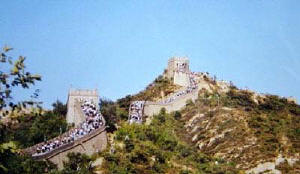 Wall. The incredible man made structure is one of the Seven Wonders of the World and rightly so. Incredible. Breath taking. Immense. Everywhere you looked up and down the towering mountains, there it was. Mind boggling to think that this entire creation, over two thousand miles long and wide enough to accommodate several side-by-side horses, was laid entirely by hand. We arrived in Badaling and walked on a mere portion of Wall before we found ourselves winded and our legs aching from the sheer steep rise of the Wall. It felt as though we were walking at a 60-degree incline. As we rested along the way to the top, we watched some of the children attempt to run up the brick-paved path only to end up gasping once they reached one of the beacon towers. One small child was wearing an interesting hat that was round, rimless, and had a long, braided queue attached to the back of it to give the illusion that it was the child’s own hair trailing down. Despite the amusing headgear the child had on, we had to give him credit – he was being carried while we labored uphill by ourselves. The descent was much faster (occasionally dangerously so) and once we reached the exit and got past all of the pushy vendors, we took a moment to admire the creation one last time before heading back to Beijing. The Wall and the surrounding mountainside was an amazing and awe-inspiring place and definitely a sight not to be forgotten.
Wall. The incredible man made structure is one of the Seven Wonders of the World and rightly so. Incredible. Breath taking. Immense. Everywhere you looked up and down the towering mountains, there it was. Mind boggling to think that this entire creation, over two thousand miles long and wide enough to accommodate several side-by-side horses, was laid entirely by hand. We arrived in Badaling and walked on a mere portion of Wall before we found ourselves winded and our legs aching from the sheer steep rise of the Wall. It felt as though we were walking at a 60-degree incline. As we rested along the way to the top, we watched some of the children attempt to run up the brick-paved path only to end up gasping once they reached one of the beacon towers. One small child was wearing an interesting hat that was round, rimless, and had a long, braided queue attached to the back of it to give the illusion that it was the child’s own hair trailing down. Despite the amusing headgear the child had on, we had to give him credit – he was being carried while we labored uphill by ourselves. The descent was much faster (occasionally dangerously so) and once we reached the exit and got past all of the pushy vendors, we took a moment to admire the creation one last time before heading back to Beijing. The Wall and the surrounding mountainside was an amazing and awe-inspiring place and definitely a sight not to be forgotten.
On Sunday, still enjoying the national extended holiday weekend, we drove to Yihehuan, the Summer Palace where emperors and empresses would frolic after escaping from the rigors of palace life in the Forbidden City. We bargained a bit in our Chinglish ("Duo shao chyan?" - "how much are they" in Chinese - and "no no, too much" in English) and purchased a few postcards before we toured the Palace. We strolled along Kunming Lake, the charming gardens, and the tranquil park. We saw the Hall of Benevolence and Longevity, the Cloud Dispelling Hall, and the Palace of Virtue and Harmony. The names were marvelous and so much more elegant and descriptive than Ronald Reagan Washington National Airport. A boat tour took us around the lake to the Long Corridor, which, true to its name, is mighty long – about half a mile along the shore. The corridor is painted inside and out with scenes of Chinese flowers, animals, myths, and people. During the Cultural Revolution, the Red Guards took whitewashed over all the paintings but an attempt has been made since then to restore them to their original appearance. It is a shame that so much art was systematically destroyed in those years. The last sight we viewed in Yihehuan was Empress Ci Xi's famous Marble Boat. Apparently, the good Empress told her people that although she regretted it, she needed to tax them to raise money for a navy to ward off invaders. Money in hand, she changed her mind and decided to build a lavish, marble boat upon which to hold parties and dinners. She was not very popular.
Our next stop was Tian Ten, the Temple of Heaven, considered to be the exact meeting point of Heaven and Earth. Historically, the Temple of Heaven was so sacred that the citizens could not even look upon it, especially because the complex was part of the Forbidden City which was not open to us mere peons until 1912. Now, even foreigners are permitted to gaze upon the Temple, see the wonder of the blue-topped Hall of Prayer for Good Harvest, and walk around grounds and admire the classic Ming architecture at will. We ended our day with some delicious roasted yams from the street vendors outside of the Temple.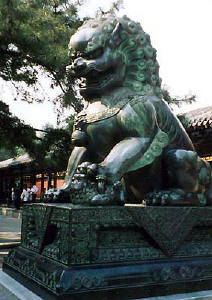 After four days of holidays, Monday hit. People were driving to work, helter-skelter traffic started up again, and factories began churning out acres of thick, nasty pollution. When I got up at 7am (thanks to the evil, torturous cuckoo clock) and looked outside, it appeared very foggy . . . but the fog never lifted. It wasn't fog; it was unadulterated pollution. Tiananmen Square was on the agenda this day so we hailed a cab to take us there. One aside: the inside of Chinese cabs are so funny; they are like some American cabs in that they have a glass partition between the front and back seats, but for added protection (although I don't know if it's for our protection or theirs), they have another glass partition between the front passenger's side and the driver's side. This means the driver has to tool around the city in a cramped little plastic box a quarter of the size of the car all day with only a small sliding box to receive any fares.
After four days of holidays, Monday hit. People were driving to work, helter-skelter traffic started up again, and factories began churning out acres of thick, nasty pollution. When I got up at 7am (thanks to the evil, torturous cuckoo clock) and looked outside, it appeared very foggy . . . but the fog never lifted. It wasn't fog; it was unadulterated pollution. Tiananmen Square was on the agenda this day so we hailed a cab to take us there. One aside: the inside of Chinese cabs are so funny; they are like some American cabs in that they have a glass partition between the front and back seats, but for added protection (although I don't know if it's for our protection or theirs), they have another glass partition between the front passenger's side and the driver's side. This means the driver has to tool around the city in a cramped little plastic box a quarter of the size of the car all day with only a small sliding box to receive any fares.
Tiananmen Square: largest public square in the world, home of the Great Hall of the People, and most known for the massacre that occurred in 1989. It was much less crowded after the holidays, so we were free to wander at a leisurely pace. A huge portrait of Chairman Mao greeted us at the entrance of the Forbidden City which contained hall after hall of ornate pillars, huge thrones, gilded ceilings, carved dragons and lions and bears oh my, and a fortune in jewels. The interior was vast and hushed. Each room seemed more opulent than the next. One intriguing piece of handiwork was a five foot jade carving of a mountain complete with intricately sculpted miniature trees, animals, and people. Another room contained delicate porcelain while yet another featured gleaming, deadly weapons. The city was so grand and spacious that we actually did not even get to the other end and certainly did not see all 9,999 rooms because we finally lost steam and only had enough energy to retrace our steps and hail a cab back home.
 Having seen the main sights Beijing had to offer, we discussed plans to visit Shanghai and southern China for a few days. Once we arranged our flights and accommodations for the next day, we spent the rest of the afternoon going to the Xiushui Silk Market. We passed by the sidewalk vendors who, as we quickly learned, had no license to sell their wares and therefore kept all of their goods on a blanket that cleverly converted into a bag in an instant for those times when the police came by so that they could run across the sidewalk to the bus stop and look like innocent bystanders. It was as though they had choreographed the whole scene. One second they were sitting on the side, calling out to "Lookah lookah, very nice," and the next second, everything was packed up and they were gone in a flash only to return a few minutes after the police had moved away. Imagine a flock of pigeons milling about, scattering in a flurry of feathers at the sound of a loud noise, and then almost immediately coming back as though nothing had happened. It was an impressive and amusing event to witness.
Having seen the main sights Beijing had to offer, we discussed plans to visit Shanghai and southern China for a few days. Once we arranged our flights and accommodations for the next day, we spent the rest of the afternoon going to the Xiushui Silk Market. We passed by the sidewalk vendors who, as we quickly learned, had no license to sell their wares and therefore kept all of their goods on a blanket that cleverly converted into a bag in an instant for those times when the police came by so that they could run across the sidewalk to the bus stop and look like innocent bystanders. It was as though they had choreographed the whole scene. One second they were sitting on the side, calling out to "Lookah lookah, very nice," and the next second, everything was packed up and they were gone in a flash only to return a few minutes after the police had moved away. Imagine a flock of pigeons milling about, scattering in a flurry of feathers at the sound of a loud noise, and then almost immediately coming back as though nothing had happened. It was an impressive and amusing event to witness.
We entered the Silk Market where the vendors had proper licenses and stalls and had no need to sprint away at a moment's notice. There were a lot of name-brand clothes, silks, cashmeres, and shoes to choose from and we spent a few hours there honing our bargaining skills: negotiating about 50% off of the asking price, offering to buy several items at once and getting a deal on the whole lot, and holding the money we were prepared to spend on an item in plain view so that the vendor could see it (we learned that it is harder for the seller to say “no” to money that they can see and almost touch rather than to a random figure floating in the air between the bargainers). We returned with our purchases, packed up enough clothes for a week, and got an early night's rest in anticipation of our trip to Shanghai the next morning. 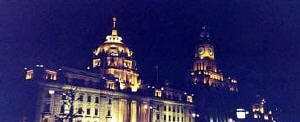 Did I mention how polluted Beijing is? It was so polluted that our host almost missed our exit to the airport because the huge building he uses as a landmark was completely shrouded in thick car- and factory-emissions and was nearly invisible. At the airport, we managed to make it to the Eastern China Airways desk, paid the departure tax, and two hours later arrived in Shanghai. The airport was pleasantly clean and nice and after being greeted by a representative of the Peace Hotel, we were afforded our first glimpse of Shanghai, which was also clean and nice. It was a very western looking city with the same huge neon advertisements as in Beijing and many familiar chain stores. For you history buffs, our hotel was originally known as the Cathay Hotel and Sassoon House, so named after Victor Sassoon, a man from Baghdad who made his fortune selling opium in the 1930s. Known as the “No.1 Mansion in the Far East,” the hotel acted as a writing space for Noel Coward (“Private Lives”), a setting for Stephen Spielberg (“Empire of the Sun”), and is one of the few buildings from 1920s Shanghai that is remaining (the rest having been refurbished, polished, and built up to sky scraper proportions). The Peace Hotel overlooks the Huangpu River and the Bund, which is the wonderful waterfront promenade. The Bund is very peaceful and well kept and frequented by only a few kids with exposed bottoms peeking through the holes in their pants. After exploring the marketplace, we walked along the Bund, saw the numerous and various ships gliding by, and watched several elderly but very flexible folks practice their evening exercises of Tai Chi on the street (repeat performances were to be had in the mornings as well).
Did I mention how polluted Beijing is? It was so polluted that our host almost missed our exit to the airport because the huge building he uses as a landmark was completely shrouded in thick car- and factory-emissions and was nearly invisible. At the airport, we managed to make it to the Eastern China Airways desk, paid the departure tax, and two hours later arrived in Shanghai. The airport was pleasantly clean and nice and after being greeted by a representative of the Peace Hotel, we were afforded our first glimpse of Shanghai, which was also clean and nice. It was a very western looking city with the same huge neon advertisements as in Beijing and many familiar chain stores. For you history buffs, our hotel was originally known as the Cathay Hotel and Sassoon House, so named after Victor Sassoon, a man from Baghdad who made his fortune selling opium in the 1930s. Known as the “No.1 Mansion in the Far East,” the hotel acted as a writing space for Noel Coward (“Private Lives”), a setting for Stephen Spielberg (“Empire of the Sun”), and is one of the few buildings from 1920s Shanghai that is remaining (the rest having been refurbished, polished, and built up to sky scraper proportions). The Peace Hotel overlooks the Huangpu River and the Bund, which is the wonderful waterfront promenade. The Bund is very peaceful and well kept and frequented by only a few kids with exposed bottoms peeking through the holes in their pants. After exploring the marketplace, we walked along the Bund, saw the numerous and various ships gliding by, and watched several elderly but very flexible folks practice their evening exercises of Tai Chi on the street (repeat performances were to be had in the mornings as well).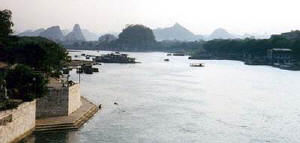 The next morning, we had breakfast at the top of the twelve-story hotel in one of the several restaurants (your choice of Shanghai, Cantonese, Sichuan, or French cuisine) with a beautiful view of the Huangpu River. We planned to make it out to the docks in time for the 9am boat tour. Unfortunately, despite our guidebook’s guarantee, the 9am tours are no longer being offered. We purchased tickets for a 2pm boat tour instead and filled our time by ambling around the Bund and discussing our plans to visit our next destination, Hangzhou. Hangzhou is “one of the most beautiful cities in China” as several Chinese told us and “the finest, most splendid city in the world” as Marco Polo is claimed to have pronounced it. In one of our more adventurous/silly moods, we decided to forgo the recommended CITS (China's International Travel Service) and went to an unnamed travel agency with offices conveniently located on the Bund with a sign was written in Chinese and in English. As it turns out, no one there actually speaks any English. While we were flailing around trying to make ourselves understood, a stranger on his way to the bank stopped by, heard us speaking English, and decided to come to our aid. Meet Mr. Bill Wu, friendly neighborhood interpreter. He was very nice and arranged for us to take the morning train to Hangzhou, get picked up by a guide with a van, go to the hot spots of the town, have lunch, take a boat tour on the West Lake, and get back to the train to Shanghai for about $45/person. We thanked him profusely for his help and after some shopping and a light lunch, we boarded our tour boat.
The next morning, we had breakfast at the top of the twelve-story hotel in one of the several restaurants (your choice of Shanghai, Cantonese, Sichuan, or French cuisine) with a beautiful view of the Huangpu River. We planned to make it out to the docks in time for the 9am boat tour. Unfortunately, despite our guidebook’s guarantee, the 9am tours are no longer being offered. We purchased tickets for a 2pm boat tour instead and filled our time by ambling around the Bund and discussing our plans to visit our next destination, Hangzhou. Hangzhou is “one of the most beautiful cities in China” as several Chinese told us and “the finest, most splendid city in the world” as Marco Polo is claimed to have pronounced it. In one of our more adventurous/silly moods, we decided to forgo the recommended CITS (China's International Travel Service) and went to an unnamed travel agency with offices conveniently located on the Bund with a sign was written in Chinese and in English. As it turns out, no one there actually speaks any English. While we were flailing around trying to make ourselves understood, a stranger on his way to the bank stopped by, heard us speaking English, and decided to come to our aid. Meet Mr. Bill Wu, friendly neighborhood interpreter. He was very nice and arranged for us to take the morning train to Hangzhou, get picked up by a guide with a van, go to the hot spots of the town, have lunch, take a boat tour on the West Lake, and get back to the train to Shanghai for about $45/person. We thanked him profusely for his help and after some shopping and a light lunch, we boarded our tour boat.
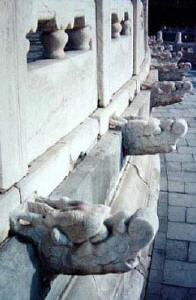 We sailed along the shores of Shanghai and picked out our new home by its green pyramid at the top. We slid by the many ports and docked ships, saw the Lupu bridge (the world's biggest arch bridge with a main span of 550 meters) and before long, reached the East China Sea and the Yangzi River. Because the scenery was the same on the way back as it was on the way out, the crew entertained us with a magic show for an hour on our return: piped in music (for some reason, they loved playing Auld Lang Syne – I must have heard it about 10 times that day in different places), big toothy smile, no words, and lots of arm waving. We sipped green tea, admired the skyline, and by evening, we were back in Shanghai. When we returned to the hotel, we got a call from none other than Mr. Bill Wu. He wanted to make sure that we were all right and that we had the tickets for the train the next day. He proposed that if we didn't have other plans, he would like to offer his services as a guide to Shanghai. We were stunned (actually, my mother and I, having read too many mysteries in our day, and my sister and I, having seen too many "X files" episodes, were very suspicious). My father was as calm and trusting as always and invited him instead for dinner the day after we returned from Hangzhou.
We sailed along the shores of Shanghai and picked out our new home by its green pyramid at the top. We slid by the many ports and docked ships, saw the Lupu bridge (the world's biggest arch bridge with a main span of 550 meters) and before long, reached the East China Sea and the Yangzi River. Because the scenery was the same on the way back as it was on the way out, the crew entertained us with a magic show for an hour on our return: piped in music (for some reason, they loved playing Auld Lang Syne – I must have heard it about 10 times that day in different places), big toothy smile, no words, and lots of arm waving. We sipped green tea, admired the skyline, and by evening, we were back in Shanghai. When we returned to the hotel, we got a call from none other than Mr. Bill Wu. He wanted to make sure that we were all right and that we had the tickets for the train the next day. He proposed that if we didn't have other plans, he would like to offer his services as a guide to Shanghai. We were stunned (actually, my mother and I, having read too many mysteries in our day, and my sister and I, having seen too many "X files" episodes, were very suspicious). My father was as calm and trusting as always and invited him instead for dinner the day after we returned from Hangzhou.
We woke up at 5:45am to start our trip to Hangzhou. Armed with several slips of papers with instructions in Chinese written out by our helpful travel agents, we hailed a cab and passed a message to the driver requesting that she "Please take us to the new train station" (not to be confused with the old one). Fifteen minutes and a mere buck fifty later, the four of us were at the train station. We approached an old man and handed him our second note: "Please show us the way to the foreigners' entrance." Instead of pointing out where we should go, the gentleman actually led us all the way there! We conducted our business, sat down on some soft seats in the relatively clean station and ate some honey sandwiches that we had made earlier for breakfast. We boarded the train and at exactly 7:30am, I mean ON THE DOT, the express train left the station.
The countryside was simply beautiful and we were astonished by how exactly and precisely laid out the rice paddies and gardens were. The land was picturesque and the occasional townhouses and condos in the middle of nowhere almost seemed out of place. We chatted for two hours, relaxed on the comfortable seats, and arrived in Hangzhou by 9:30am. At the station, we were greeted by our English speaking tour guide "Wayne, as in John Wayne." His real name is Tsan Wong, but he found that foreigners were more comfortable with Wayne. My father was quick to point out that his resemblance to the Duke was minimal. As we drove past the town and the Grand Canal (1112 miles from Beijing to Hangzhou, the longest canal in the world), Wayne gave us some history of the town, which during the Song dynasty, was China's capital from 1127 to 1279. 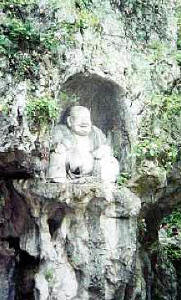 Our first stop was the Bhuddist Temple Lingyin, the Temple of the Soul's Retreat, created in 326 AD. Our guide explained that each color had meanings (yellow for power, red for fidelity, blue for wisdom) and that during the Cultural Revolution, the Red Guards tried to destroy the various statues, including the Laughing Buddha, but the local students protested, held them off, and succeeded in saving the statues. One image of Buddha was carved out of 24 sections of a single camphor tree and gilded with 104 ounces of gold. The statue stood placidly amidst the wafting ribbons of incense and gentle, murmured prayers. Along with the serene sculptures, there were also some nightmarish carvings and ghoulish stories about one of the guardians with a history of eating children. Gotta have balance.
Our first stop was the Bhuddist Temple Lingyin, the Temple of the Soul's Retreat, created in 326 AD. Our guide explained that each color had meanings (yellow for power, red for fidelity, blue for wisdom) and that during the Cultural Revolution, the Red Guards tried to destroy the various statues, including the Laughing Buddha, but the local students protested, held them off, and succeeded in saving the statues. One image of Buddha was carved out of 24 sections of a single camphor tree and gilded with 104 ounces of gold. The statue stood placidly amidst the wafting ribbons of incense and gentle, murmured prayers. Along with the serene sculptures, there were also some nightmarish carvings and ghoulish stories about one of the guardians with a history of eating children. Gotta have balance.
On a tour of a local tea plantation, Wayne tried to convince us that if we ate one type of prize winning, world coveted tea known as Dragonwell, which is conveniently only grown in Hangzhou and although not available in the market, would be sold to us for a nominal price, we would feel a fresh taste in our mouths and would not be thirsty the rest of the day. Uh huh. We sampled some tealeaves, even experienced a tea ceremony (first cup to smell, sip, second cup to taste, sip, third cup to contemplate, sip), but did not experience any of the astounding attributes Wayne tried to sell us. My father argued with him for a while about the tea's ability to prevent cancer, tumors, and cataracts. Finally, without buying any tea, but happily buying a Yixing teapot (a beautiful, delicate piece of work, it was the only item in China I specifically intended to buy), we drove around the West Lake. Over lunch, we talked to Wayne quizzically about the city and carefully about communism. We decided to exchange a tour of another temple and pagoda with a tour of a silk factory instead where we learned about and saw silk worms, the cocoons, the looms, and the final products on display.
West Lake boasts a pretty, winding garden, many flowering osmanthus trees which had a pleasing, citrus smell, and a boat tour that provided great views of the pagodas, pavilions, causeways, and arched bridges. On a tour of an oyster farm, we observed no less than 20 pearls come out of one oyster (a violent method to extract them, but intriguing nonetheless). In the evening, we drove by Six Harmony Pagoda, saw a double decker bridge, and witnessed a river flowing AWAY from the sea because it was drawn by the moon's pull in the other direction. After a quick dinner, we returned to the train station to catch our train back to Shanghai.
***The following paragraph may be too graphic for young readers. Parental discretion is advised.***
Now, not too much has been discussed about the facilities in China. Most of this is due to the fact that we tried our best to use either the bathrooms in the hotels or to wait until we were home. On the train, the bathroom was pretty decent: the seat was clean, the hole led directly to the visible train tracks, and it was early in the morning. The train station in the late evening after a full day of travelers and their full bowels, my friends, is another story. Unimaginable, mephitic nastiness. I had to hold my breath for as long as I could and then breathe through my mouth lest I vomit and add to the impossibly vile smell. The toilet was full and the seat was suspiciously wet. Even thinking about it now is making me queasy. Remember the scene in “Trainspotting” – the Filthiest Toilet in Scotland? This was China’s equivalent. Disgusting story short, I was out of there as fast as humanly possible without touching anything, without fainting, and without regurgitating my lunch. Now, back to our regularly scheduled, less vulgar program.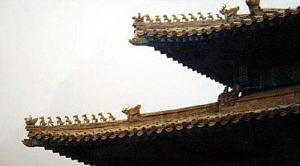 Upon our arrival in Shanghai, we whipped out our last slip of paper: "Please drive us to the Peace Hotel." Our cab driver was angry for getting caught in a non pick up area to pick us up and received a ticket for his pains. He then proceeded to drive very fast and insisted on honking for no reason, even when there were no cars around. We reached the hotel, had dinner at the opulent French restaurant, and rested our weary bones.
Upon our arrival in Shanghai, we whipped out our last slip of paper: "Please drive us to the Peace Hotel." Our cab driver was angry for getting caught in a non pick up area to pick us up and received a ticket for his pains. He then proceeded to drive very fast and insisted on honking for no reason, even when there were no cars around. We reached the hotel, had dinner at the opulent French restaurant, and rested our weary bones.
On our last day in Shanghai, we sought out the Yuyuan Market. We passed a leper on the way begging for money. It was the first time I had seen anyone with leprosy and she looked almost cartoonish with such big pink patches on her skin and bloated lips. We moved on and used our limited Chinese to find the bazaar, one of the few places in Shanghai that retains the old, Chinese architecture. We saw a woman selling puppies (noteworthy as they were the only animals I had seen on the entire trip) that were actually dyed different colors to attract attention. One tiny newborn was painted with black and orange stripes and looked like a minuscule, shaking tiger. We tried to take a picture of it, but when the woman saw a camera rather than cash, she quickly closed the flap to the cardboard box she was carrying the puppies in and scurried off. At the Shanghai Friendship Store, my father discovered the antique section and spent so much time browsing there that before long, he had a flock of sales people following him around and whatever item he spent more than a few seconds lingering over, they took out of the glass case to show him. Of course, he wanted to look at everything. We were there for a while.
We finally dragged my father out of the museum-like store, walked back to the hotel, ate at the nice Japanese restaurant, and retired to our rooms for a nap. Dinner with Mr. Wu was a pleasant surprise; he was not the evil spy we thought he might be (well, we determined that he was not evil at any rate). In fact, he was very nice. He talked about his son in LA, how proud he was of him, how he was sorry his wife could not attend but she was at work (Aha! Wife is alive after all!), and how much he liked our family. He brought over some pictures of his family for us to look at and told us about life before and during communism's heyday, about Mao, and about his work as an engineer. We passed around addresses, took some pictures, and ended our lovely stay in Shanghai.
In the pre-dawn morning, we packed, took a shuttle to the airport, had icy cold bananas for breakfast (yes, it is as unappetizing as it sounds), and two hours later, we arrived in Guilin in southern China. 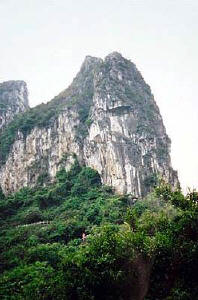 The scenery is incredible and rolling with these tall, rounded peaks and gentle valleys you may have seen in traditional Chinese landscape paintings. After checking into our hotel and arranging for the next day's tour of the city, we crossed the gorgeous Li River and walked along the banks. We were approached by no less than three "students/teachers of English" who wanted to talk to and practice their language skills with us. We did some window-shopping and were goggle-eyed when we saw the variety of the exotic medicines that were sold at the pharmacies. We did some windowless-shopping at the huge open-air market as well and ended up negotiating for some fresh fruit and vegetables for dinner. Back at the hotel, our evening ended when we arrived just in time to see a bride and groom emerge with an entourage, a drum band, and two paper-mache dragons in tow.
The scenery is incredible and rolling with these tall, rounded peaks and gentle valleys you may have seen in traditional Chinese landscape paintings. After checking into our hotel and arranging for the next day's tour of the city, we crossed the gorgeous Li River and walked along the banks. We were approached by no less than three "students/teachers of English" who wanted to talk to and practice their language skills with us. We did some window-shopping and were goggle-eyed when we saw the variety of the exotic medicines that were sold at the pharmacies. We did some windowless-shopping at the huge open-air market as well and ended up negotiating for some fresh fruit and vegetables for dinner. Back at the hotel, our evening ended when we arrived just in time to see a bride and groom emerge with an entourage, a drum band, and two paper-mache dragons in tow.
We met our English speaking tour guide Ms. Tan in the morning and began with Elephant Trunk Hill, a mountain that is shaped with a hole in the middle so that it resembles an elephant with its trunk dipped in the limpid Li River. We saw a monkey perform (stand, salute, sit) and a cormorant, which is a slender-throated black bird that fishermen use to catch fish. The cormorant had a ribbon tied around its neck so that when it dives in the water, it can swallow the small fish, but has to return the larger ones to the fisherman and get a treat as reward. At Fubo Hill, one of Guilin’s famous limestone karst, we climbed over 300 steps to the top of the peak for a spectacular view of city. Our thighs were aching and quivering by the time we made it back down. The next visit was to Solitary Beauty Peak and then to Reed Flute Cave, which was a cave so large that during WWII, it served as an air raid shelter when America's Flying Tiger squad was based in Guilin. The stalactites and stalagmites jutting out along the chilled route through the cave and the crystal formations were fascinating. When we emerged from the cool quiet of the cave, we were accosted by loud, ear piercing sales pitches from people selling postcards, reed flutes, and wooden whistles. Even a little three-year-old girl, barely up to my knee, was hawking "Hello, one yuan. Hello, one yuan" to sell her whistles.
Surprisingly, Guilin has a pretty decent size Muslim community, large enough to warrant a mosque and several Muslim restaurants. We went to a restaurant near the mosque and managed to feed all six of us (family, guide Ms. Tan, and the driver) for a little over a dollar a person for soup, rice, chicken, and candied yams. We looked around the mosque where my father proceeded to amaze Ms. Tan by reading the Chinese script along the side (he was actually reading the Arabic and the Chinese script under it was just the phonetic version). Upon our return, my father and I decided to guide ourselves around the town. When we stopped to buy apples in the marketplace and tried to use what little Chinese we picked up during our visit, we managed to attract a decent-sized crowd. One fellow spoke some English and struggled very hard to explain that these apples were better than those. We made ourselves understood after a lengthy bout of hand gestures, finger counting, and repetition, and returned triumphantly with four apples. We were quite proud of ourselves.
When we arrived at the airport early in the morning to catch our flight back to Beijing, I made an interesting observation. Unlike American boarding procedures (“Now boarding rows 20 to 30 (pause) 10 to 20 (pause) etc."), the Chinese board like so: silence, general milling around, and then a booming voice “NOW BOARDING!" A melee ensues, elbows start flying, and people are crushed in the insane attempt to board all at once. Lucky for me, my bony elbows came in handy as I warded off my more fleshy co passengers. The scene was very similar to the unlicensed vendors making a mad dash for safety before the cops caught them. Three hours later, we were back in rainy, chilly Beijing.
The remainder of our stay in Beijing consisted mostly of shopping. We had perfected our bargaining skills, learned a few more words "Eh, pungyo" (Hey, friend!), and often found ourselves mesmerized by the military precision with which the traffic guards directed the whizzing cars, bicycles, and pedestrians on the street. We were lucky enough to catch an astonishing Chinese acrobatic show. One woman, with a Tibetan backdrop behind her, balanced glass-encased candles on both of her feet, both of her hands, and on a stick in her mouth. Several strong men climbed poles with lightening speeds using only their arms with their bodies parallel to, but away from, the poles. Some magic, some dragon dances, some clowning around. Then, one woman held five girls on her shoulders with a harness while the girls spun plates on sticks while she also spun plates on sticks. It was incredible. We had a great experience, wonderful memories, and so ended our fabulous trip to the Middle Kingdom.
All the text above is copyright 1998 Tasneem

